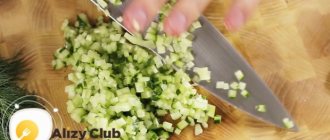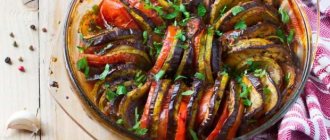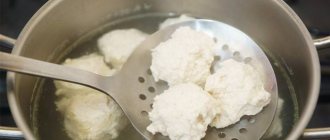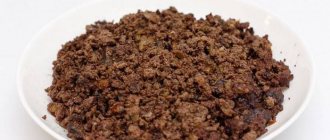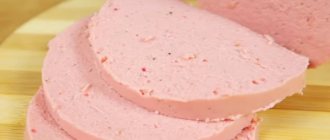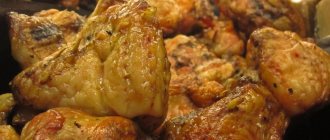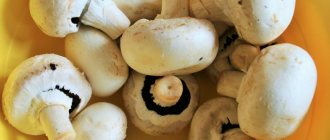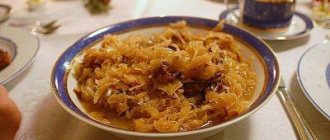Publication in the group: Dishes from cottage cheese, dairy products
Halloumi cheese is a cheese that is traditionally made on the island of Cyprus from goat's, sheep's milk or a mixture of both. The recipe for this Mediterranean delicacy is distinguished by the absence of acid-forming bacteria or acid and the presence of rennet. In addition, when making such cheese, the milk component undergoes heat treatment, which gives the product properties that differ from those of other cheeses.
For centuries there has been debate over the origins of halloumi. However, archaeologists have discovered historical artifacts proving that this now increasingly popular product was made in Cyprus back in the 16th century. Therefore, in 1990 in the USA, authorship was recognized specifically for this island.
Dishes:
- 3-5 liter saucepan;
- kitchen thermometer (or you can use a multicooker with a multicooker, which will allow you to set the temperature);
- slotted spoon and colander;
- cheese mold or cheesecloth;
- measuring spoons.
Pour the milk into a saucepan and heat to 31-32 degrees. Remove from heat. We dilute Rennin in water and add it to milk. Mix thoroughly and leave for 40-50 minutes until a jelly-like mass forms.
Carefully cut the resulting clot with a spatula or knife into 1-1.5 cm squares (mesh). We wait a couple of minutes, then move a spatula inside the mass parallel to the surface of the pan - thus cutting the cheese curd in half to make cubes from the rectangles. Over medium heat, gradually warm the whey to 40 degrees, gently stirring the cheese mass, as if setting the cubes (cheese grain) in motion. As soon as the temperature reaches 40 degrees, remove the pan from the heat, cover with a lid and leave for another 30-40 minutes.
Periodically you need to stir and break large pieces of cheese mass so that they are approximately the same size. In the process, the cheese cubes will “harden” and settle to the bottom, and the whey will become more transparent and yellowish. Transfer the cheese grains into a colander using a slotted spoon, trying to get rid of some of the whey in the process.
When all the grain is in the colander, you need to squeeze it out as much as possible, pressing it against the walls with a slotted spoon. Then we transfer the mass into cheesecloth and again into a colander or into a cheese mold. We put a small load. And leave it for half an hour. After half an hour, we turn the cheese over and place the load again, but with a larger mass.
After another half hour, repeat the procedure, increasing the load again. If the whey has stopped draining, you can proceed to the last stage. Sometimes I let the cheese drain in the refrigerator overnight. The serum must be warmed up again, but to 85-90 degrees. Remove the pan from the heat, immerse the cheese in the hot liquid and leave for 40-45 minutes.
By the end of the “cooking” the cheese will float to the surface. Mix coarse sea salt and mint on a board. Halloumi is almost ready! Using a slotted spoon, remove the hot cheese from the whey. Having blotted it with a napkin, while it is still hot, slightly flatten it, turning it into a disk. Roll in salt and mint, fold in half, press the halves together.
That's all! Any cheese still needs to “rest.” Wrap in cling film or place in a container for a day. And invite your friends to a barbecue!
Halloumi cheese recipe
Cypriot cheese Halloumi (Haloumi), long considered the hallmark of this island, is a fresh pickled cheese.
In the classic recipe, it is prepared with the addition of dried mint, which gives a special identity to Cypriot cheese, enhances and refreshes the taste, and helps to increase shelf life, since mint has a natural antibacterial effect. In addition, mint also has health benefits - it improves digestion. Halloumi is a cheese with a layered, brittle, melted and smooth texture, slightly creaking on the teeth, with a spicy, delicate taste, suitable for grilling and frying.
*
Equipment:
- stainless steel pan
- drainage mats
- knife for cutting cheese
- thermometer
- molds for soft cheeses - 2 pcs per 1 kg, 4 pcs per 0.5 kg or 6-8 pcs per 300-400g
- measuring spoons
- ricotta mold
- drain pan
- colander spoon or large slotted spoon
*
Ingredients:
– milk – 10 l + 1 l (1% of whey volume)
— 1/10 of a package per 100 liters of dry rennet Carlina 1650, dissolved in 50 ml of water
- 10g (1g per 1l of whey) Citric acid dissolved in 100ml water (for Ricotta)
– salt – 35g
- dried mint - 10g (if desired, instead of mint you can add various herbs and spices - pepper, paprika, dill, garlic, herbes de Provence)
Cheese yield – 12-15%
*
Preparation:
1. Slowly heat the milk to 32°C for 20-25 minutes (or cool the pasteurized milk).
2. Remove from heat, add the pre-diluted enzyme to the milk, and mix gently.
3. Leave the milk to form a clot for 45-60 minutes.
4. Using a knife, cut the resulting cheese curd first vertically, then horizontally into small cubes with a side of 2 cm.
5. Reheat the grain for 20 minutes to 38°C, constantly stirring slowly and cutting large pieces. During the mixing process, the grain will become denser and smaller.
6. Transfer all the grain into the molds with a slotted spoon. Do not drain the whey.
7. Turn the cheese in the molds every 15-20 minutes for 1 hour.
8. Heat the whey to 85°C, add the cheese there. Cook for 20 minutes until it floats to the surface.
10. Carefully remove the cheese from the whey with a spatula or slotted spoon and transfer it back into the mold to form an outlined head or place directly on a drainage mat, add salt, sprinkle with spices and fold in half, pressing lightly and giving the Halloumi its original flatbread shape.
As soon as the cheese has cooled, it is ready to eat. You can cut it into strips, cubes or slices and fry it on the grill or frying pan. You can fry it over a fire directly on a skewer. You can also add it to salads made from fresh tomatoes and vegetables.
Bon appetit!
Store in the refrigerator for 5-7 days.
***
On a note
For halloumi, you can also use pasteurized milk with a short shelf life, just check the composition: the protein level must be at least 3.0. In addition, it will be necessary to add calcium chloride to improve the stability of the cheese grain (the amount is the same as rennin, dilute with 25 ml of water), and it is better to exclude the stage of cheese rolling, since cheese made from pasteurized milk is not so plastic and, most likely, will tear. Simply blot the cheese with a napkin and roll in a mixture of salt and mint.
How to store Halloumi?
Homemade Halloumi cheese needs to be stored correctly in order to get all the benefits and bright taste from the product. Cheese makers recommend studying the storage rules no worse than the intricacies of the cooking recipe.
Homemade Halloumi cheese differs from store-bought cheese in the absence of preservative components. Therefore, you need to carefully observe the temperature regime. Additionally, it is recommended to monitor the humidity level in the storage area.
The best storage container is a stainless steel pan. This can also be an enamel container, but the coating must not be damaged. The temperature that homemade cheeses can tolerate is up to 4 degrees. Humidity should be at least 90%, but no more.
In the refrigerator, cheese should be allocated a compartment for vegetables. Fish and other foods with strong odors should not be placed nearby. You can make a separate place where you can put your own cheese. Recommended storage period is 3-5 days.
Summer salad with halloumi
For 2 servings:
- a couple of watermelon slices;
- 1 small nectarine;
- salad mixture (arugula, chard, frisse);
- 6 slices halloumi;
- herbs (to taste, for example, oregano);
- vegetable oil for frying.
Peel the watermelon and remove seeds, cut into small triangles. Cut the nectarine into slices. Place the leaf mixture on a plate and scatter the watermelon and peach on top. Heat a frying pan well, lightly spray with vegetable oil, and fry the halloumi slices on both sides. Place the halloumi on top of the salad preparation.
Useful tips
Even for those who are just learning the theoretical preparation, Halloumi cheese at home is accessible. But you need to remember the advice of practicing home cheese makers.
What home cheese makers should remember:
- To preserve the taste of the product, you need to add fresh mint in moderation.
- It is recommended to store soft cheese for no more than a couple of days.
- Brine and any other cheese is combined with basil, oregano, caraway seeds, thyme, and dill.
- It is not recommended to use a store-bought spice mixture; it will give minimal aroma and taste.
- One way to salt cheese is to rub it with dry salt to create a crust. But Halloumi is only made in brine.
- Cheeses do not make their milk older than 12 hours.
- For those who work with cheeses, it is recommended to have a tool for cutting curds.
Halloumi cheese originated in Mediterranean countries. To prepare it, milk from cows and goats is used. Thanks to multi-stage heat treatment, the product acquires a dense structure. And adding spices and mint at the final stage helps improve the taste and aroma.
Cypriot bulgur with halloumi and vegetables
For 2 servings:
- 120 g bulgur;
- a handful of vermicelli;
- a quarter of the onion, cut thinly into half rings;
- 2 tbsp. l. tomato paste;
- hot pepper or hot pepper sauce;
- a couple of lemon slices;
- vegetable oil;
- 150 ml water or chicken broth;
- 6-8 slices of halloumi.
Heat a frying pan with vegetable oil over medium heat. As soon as the onion becomes soft and transparent, add the vermicelli and cook for a couple more minutes. Add the washed bulgur, then the broth, pepper, lemon juice and tomato paste. Stir and leave to evaporate over medium heat. At the end, don’t forget to add salt to taste. Fry the halloumi in a frying pan and place it on top of the bulgur. Bake vegetables nearby, cut into slices or rings (onion, tomato) and add to the dish.
Ricotta recipe
Ricotta is a fresh whey Italian low-fat cheese. It has a delicate soft airy structure, you can spread it on bread, add berries, herbs, garlic, spices, mushrooms, fish, salami, cream to it, in general, it is good as a basis for a light healthy breakfast.
Ricotta is prepared from the remaining whey from the cheese with the addition of milk or cream, depending on the desired fat content.
*
Preparation:
- While the Halloumi is self-pressing in the molds, heat the remaining whey to 65⁰C.
- Remove from heat and add 1 liter of milk, mix well.
- Leave the milk for 10 minutes.
- Heat the milk to 92⁰C.
- Add pre-diluted citric acid and immediately stir gently.
- Flakes will immediately begin to form.
- Catch all the flakes with a slotted spoon or strainer, transferring the entire mass into the mold.
After cooling, the cheese can be eaten. You can add salt, spices, garlic, herbs, berries, jam, whatever you like to taste to create the most delicate dessert.
You need to store this cheese in the refrigerator simply in a food container or in a ricotta mold.
Chicken rolls with halloumi
For 2 servings:
- 2 chicken fillets;
- 2 slices halloumi;
- olive oil;
- dry white wine;
- sea salt;
- freshly ground black pepper.
We beat the fillet, salt and pepper, add a few drops of vegetable oil and wine, rub it all into the surface of the meat. Place the halloumi and roll it up. We tie it with culinary thread. Preheat the oven to 200 degrees.
Heat the pan, brown the meat. Transfer to a heat-resistant dish and cook the meat in the oven until cooked (about 25 minutes). You can use a special baking bag: it only takes 15-20 minutes (depending on the size of the roll).
How to make Adyghe cheese at home in 1 hour
Popular dishes with this cheese
Halloumi cheese, which can be prepared at home, can be added to sweet and savory dishes and used as your heart desires. In Cyprus, they are accustomed to frying the product due to its special structure and density. This is the only cheese that can be cooked until it turns brown.
Halloumi is also prepared with desserts and pies are made. In Cypriot cafes you can find both sweet and savory dishes with traditional cheese. If you don't like grilling and greasy fried snacks, you can try a sweet dish that locals love to cook in the heat. This is cheese with watermelon. It is also paired with a slice of lamb, another grilled meat. Almost any homemade food favorably emphasizes the taste and aroma of this fermented milk product.
Important! For those watching their weight, it is recommended to make a light vegetable salad with cheese slices.
Halloumi cheese - what is it?
To fully understand what kind of halloumi cheese it is, the description of its characteristics and properties should be studied first.
- Halloumi cheese is a product of Levantine origin, which is made primarily from a mixture of goat and sheep milk, has a dense, flaky texture and a lightly salted, creamy taste.
- Often, on a production scale, when preparing cheese, cow's milk is added or completely replaces traditional raw materials. This fact does not have the best effect on the properties of the product, which becomes softer and loses its authentic taste charm. When purchasing halloumi in a store, you should give preference to options made from goat and sheep milk and carefully study the composition on the packaging.
- Halloumi has a high melting point, which allows it to be fried, baked or grilled, and then used as an original independent snack or as a component of salads and other dishes.
How do you eat halloumi cheese?
Studying halloumi cheese with passion, what it is eaten with and how it is prepared are the main questions that debutant tasters ask.
- Brined halloumi cheese can be a component of a cheese plate, served with fresh vegetables separately or as a component of a salad. In this manner, it can be consumed fresh or pre-fried.
- Cypriots eat halloumi with watermelon and complement it with smoked pork, lamb or soft lamb sausages.
- Halloumi cheese harmonizes perfectly with herbs, especially mint, with fish, olives or olives, and perfectly complements golden toast, slices of fresh bread or a glass of dry wine.
What can you substitute for halloumi cheese?
If the product is not available, then it is important to know what you can replace Cypriot halloumi cheese with.
- If the taste of the product is a priority, it is replaced with brined feta made from sheep's milk, after soaking it a little in water or milk.
- When it is necessary to fry an analogue of halloumi, use Adyghe cheese, suluguni or feta cheese. However, in this case, preference should be given to a product made from goat or sheep raw materials. Cheeses made from cow's milk will be softer and have a completely different taste.
